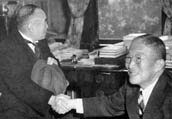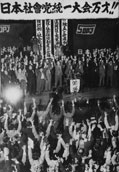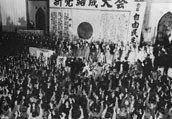HOME > Establishment of 1955 System : Outline
Outline
- a. From the YOSHIDA Cabinet to the HATOYAMA Cabinet
- b. Establishment of 1955 System
- c. Era before and after struggle over Japan-U.S. Security Treaty

YOSHIDA Shigeru and HATOYAMA Ichiro. From "Mainichi Gurafu no.186"
Ahead of the signing of the San Francisco Peace Treaty in September 1951 (Showa 26), the purge of "undesirables" from public office, including influential political figures like HATOYAMA Ichiro, was lifted. Political maneuvers to bring together anti-YOSHIDA forces gained momentum, accelerating moves toward political realignment. Public support for the YOSHIDA administration declined due to repeated dissolutions of the House of Representatives, as well as the Shipbuilding Scandal of 1954 (Showa 29). Adding to the plight of the YOSHIDA administration was the formation of the Japan Democratic Party in November 1954 (Showa 29), which was launched as a new conservative party to counter the YOSHIDA administration. Leading the new party as President was HATOYAMA Ichiro, whose Cabinet was launched after the YOSHIDA Cabinet resigned en masse the following month.
Historical materials and Description
 6-1Return of HATOYAMA Ichiro to politics
6-1Return of HATOYAMA Ichiro to politics
- New diary, 1950~1952
 6-2Formation of Japan Reform Party
6-2Formation of Japan Reform Party
- Platform of Japan Reform Party, declaration, release of policy guidelines, and others
 6-3Confrontation between YOSHIDA and HATOYAMA
6-3Confrontation between YOSHIDA and HATOYAMA
- Letter from YOSHIDA Shigeru to HAYASHI Joji and MASUTANI Shuji
- Letter from HATOYAMA Ichiro to YOSHIDA Shigeru
- Statement declaring separation from the Liberal Party
- Itinerary of election campaign for April 1953 general election
 6-4Creation of Japan Democratic Party
6-4Creation of Japan Democratic Party
- Preparatory meeting for launching new party
- Senior officials of committee for launching new party
- Draft platform
- Draft declaration, resolution and guideline for new party's organizational structure (draft)
- Party rules and codes for Japan Democratic Party (draft)
- Policy guideline (draft)
- Report by new party-naming committee
- Declaration for inaugurating Japan Democratic Party, party platform, policy guideline, party rules and codes
 6-5Resignation of Prime Minister YOSHIDA
6-5Resignation of Prime Minister YOSHIDA
- Suggestion to Prime Minister (at Cabinet meeting)

Meeting to unify Japan Socialist Party. From "Me de Miru Gikaiseiji Hyakunenshi"

Meeting to inaugurate Liberal Democratic Party. From "Showa Nimannichi no Zenkiroku vol.10"
In the general election held in February 1955 (Showa 30), the HATOYAMA Cabinet's ruling Japan Democratic Party failed to secure a majority. Meanwhile, moves to unify the Japan Socialist Party gathered impetus. The party had been divided into rightist and leftist factions due to differences over issues related to the San Francisco Peace Treaty. Under these circumstances, conservative forces stepped up efforts to join forces while the Japan Socialist Party was integrated in October 1955 (Showa 30). Capping Japan's political realignment moves in 1955 (Showa 30) was the formation of the Liberal Democratic Party following a merger in November between the Japan Democratic Party and the Liberal Party. The so-called 1955 system, in which two major parties confronted each other, was established in that year.
Historical materials and Description
 6-6Unification of Japan Socialist Party
6-6Unification of Japan Socialist Party
- Paper declaring unification of two Japan Socialist Party factions, read out at the party's meeting
- Party platform of Japan Socialist Party, party policies, and party guideline
 6-7Unification of Conservative Parties
6-7Unification of Conservative Parties
- Diary from the end of March 1955 to September 15, 1955
- Draft agenda at the meeting for launching new party
- Letter from YOSHIDA Shigeru to HAYASHI Joji and IKEDA Hayato
 6-8Japan-Soviet negotiations and the HATOYAMA Cabinet
6-8Japan-Soviet negotiations and the HATOYAMA Cabinet
- Memoranda related to Japan-Soviet negotiations
- Letter from YOSHIDA Shigeru to HAYASHI Joji
 6-9ISHIBASHI Cabinet
6-9ISHIBASHI Cabinet
- Autographs for campaign speech
In 1960 (Showa 35), when the Cabinet was led by Prime Minister KISHI Nobusuke, the ruling and opposition parties were sharply divided over the proposed revision to the Japan-U.S. Security Treaty, throwing parliamentary proceedings into confusion. Outside the Diet, strong opposition was being mounted by activists against the proposal, an unprecedented movement in Japan's history. On 19 June, the bill for the revised treaty was automatically enacted. The following month, the KISHI Cabinet resigned en masse, followed by the inauguration of the Cabinet of Prime Minister IKEDA Hayato. Prime Minister IKEDA proposed "tolerance and perseverance" as his government's policy and adopted an economy-oriented policy aimed at promoting significant growth.
Historical materials and Description
 6-10KISHI Cabinet and Police Official Duties Execution Act
6-10KISHI Cabinet and Police Official Duties Execution Act
- Paper listing demands on Diet proceedings
 6-11Japan-China relations
6-11Japan-China relations
- Greeting letter following visit to P.R. China
 6-12Formation of Democratic Socialist Party
6-12Formation of Democratic Socialist Party
- Platform issue
 6-131960 signing of new Japan-U.S. Security Treaty
6-131960 signing of new Japan-U.S. Security Treaty
- Notebook New Japan-U.S. Security Treaty (1)
- Autograph for question and answer at the House of Representatives' special committee on the Japan-U.S. Security Treaty (1)
- Diary by House of Representatives Secretary General
- Letter from EISENHOWER to KISHI Nobusuke
- Speech autograph in which dissolution of the Diet was demanded
- Comments that Japan Socialist Party Chairman ASANUMA made in Osaka
 6-14Proposal by IKEDA Cabinet to double people's income
6-14Proposal by IKEDA Cabinet to double people's income
- Manuscript of Prime Minister IKEDA's keynote speech (economic portion)